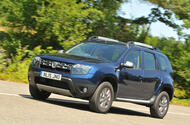This post was originally published on Autocar

The Dacia Duster is a no-nonsense machine that wears its bargain price tag like a badge of honour
The term ‘all-rounder’ is overused, but when it comes to the trusty and affordable Dacia Duster, it couldn’t be more appropriate.Having taken some 100,000 sales since its UK launch in 2013, the Duster is now cemented as one of Britain’s favourite small SUVs, and not just because it allowed people to get into a new car at an affordable price but because it was pretty decent across the board, too.The really smart money went on the first Dusters just over a decade ago. You could get a new SUV with a robust, spacious interior for just £8995 – far cheaper than the Skoda Yeti. It even undercut the Ford Fiesta and Fiat Panda.Access trim was the entry point, and while it was dirt cheap, describing its spec as spartan would be an understatement, as it got steel wheels, unpainted bumpers and no radio.It could only be had with an unhurried 104bhp 1.6-litre petrol engine, driving the front wheels as standard, but you could spec four-wheel drive for an extra £2000.Mid-rung Ambiance trim was a little better equipped, with its part-coloured bumpers, stereo (with Bluetooth and USB connection) and adjustable seat, plus it brought the option of a 108bhp 1.5-litre four-cylinder turbo diesel engine.If you wanted true luxury (by which we mean alloy wheels and air conditioning), the £14,995 Laureate was manna from heaven. Stump up an extra £470 and Dacia would even make the paint metallic. Very posh.Prestige and SE Summit trim levels came later. They featured cruise control, electric windows and heated door mirrors, but the real telltales are the diamond-cut alloy wheels and the 7.0in multimedia touchscreen.When we first drove the Duster, it gave us an unpleasantly large dose of road and wind noise, and it had more of a tendency to move around at higher speeds than the rival Yeti.Still, its diesel engine had plenty of shove, despite the unusually spaced ratios of the six-speed manual gearbox, and we couldn’t fault the ride quality, as the relatively small 16in wheels of the Laureate meant the Duster maintained a composure befitting a much more expensive SUV.It’s worth noting that safety wasn’t a selling point: the Duster was awarded just three stars in Euro NCAP’s testing (scoring poorly for pedestrian protection and safety assist), despite being fitted with anti-lock brakes, emergency braking assistance, stability control, traction control and airbags.In 2014, Dacia restyled the Duster with a new front grille and headlights and made some tweaks to its interior. A year later, it added a 123bhp 1.2-litre turbo petrol four (albeit reserved for Laureate trim). Meanwhile, the sedate 1.6 petrol engine was replaced by the 1.6 SCe, which had a bit more pep (115bhp).Your own particular needs will determine which version to go for. A ‘UN-spec’ Access model will make an ideal workhorse, and a Laureate car will have more standard kit, although the premium commanded by 4WD dents its value appeal.For day-to-day drudgery and tip-run supremacy, it has to be a mid-spec Ambiance with two driven axles.
